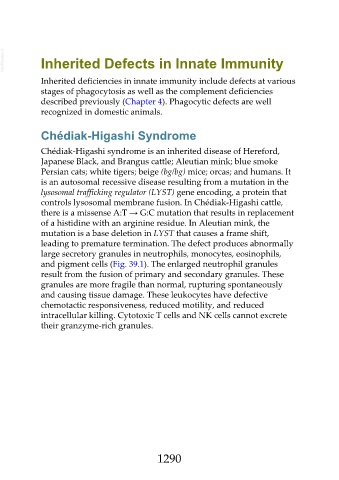Page 1290 - Veterinary Immunology, 10th Edition
P. 1290
VetBooks.ir Inherited Defects in Innate Immunity
Inherited deficiencies in innate immunity include defects at various
stages of phagocytosis as well as the complement deficiencies
described previously (Chapter 4). Phagocytic defects are well
recognized in domestic animals.
Chédiak-Higashi Syndrome
Chédiak-Higashi syndrome is an inherited disease of Hereford,
Japanese Black, and Brangus cattle; Aleutian mink; blue smoke
Persian cats; white tigers; beige (bg/bg) mice; orcas; and humans. It
is an autosomal recessive disease resulting from a mutation in the
lysosomal trafficking regulator (LYST) gene encoding, a protein that
controls lysosomal membrane fusion. In Chédiak-Higashi cattle,
there is a missense A:T → G:C mutation that results in replacement
of a histidine with an arginine residue. In Aleutian mink, the
mutation is a base deletion in LYST that causes a frame shift,
leading to premature termination. The defect produces abnormally
large secretory granules in neutrophils, monocytes, eosinophils,
and pigment cells (Fig. 39.1). The enlarged neutrophil granules
result from the fusion of primary and secondary granules. These
granules are more fragile than normal, rupturing spontaneously
and causing tissue damage. These leukocytes have defective
chemotactic responsiveness, reduced motility, and reduced
intracellular killing. Cytotoxic T cells and NK cells cannot excrete
their granzyme-rich granules.
1290

